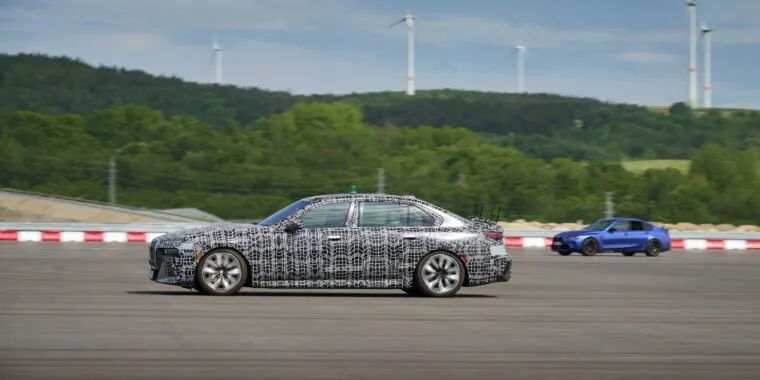On a large empty slab of asphalt, two BMWs take off. They drive in figure eights and along an oval path separate from each other but nearly in tandem, like two ice skaters practicing the same routine on a piece of black ice before coming to a stop.
Neither of the cars has a driver. That’s not that impressive; self-driving cars in testing environments shouldn’t impress anyone at this point. Essentially the automaker tells the car to drive a route, and it does it. The important thing here is why these cars, outfitted with additional sensors, are driving along the same route again and again, each time depressing the accelerator the same amount and applying the exact amount of pressure on the brakes: They’re testing hardware with the least amount of variables you can encounter outside of a lab.
“It’s boring for human drivers,” says BMW’s project lead for driverless development, Philipp Ludwig. When a human is asked to perform the exact same task repeatedly, the quality of the work diminishes as they lose interest or become fatigued. For a computer-controlled car, it can do this all day. And it has done exactly that.
Of course, this kind of computer vision and control is small potatoes for such a large company.
The engineering problems were definitely solvable more than 15 years ago to someone with an understanding of the literature. All it took was someone to bring it to market (err, the bench).
Real self driving has to handle all these unimaginably obscure edge cases in a way other than “apply the brakes” and turn off.
The engineering problems were definitely solvable more than 15 years ago to someone with an understanding of the literature.
No, it wasn’t. The models and hardware didn’t exist 15 years ago. Unless you’re talking about some of the fundamental neural network algorithms, but even then those were made back in the 60s. Not 15 years ago.
15 years ago a self driving car (an actual one capable of driving on a real road with other cars) was an impossible proposition.
Up until the recent decade anything self driving wasn’t much better than thing thing: https://youtu.be/ntIczNQKfjQ
Sweet summer child…
This type of “drive in a circle and put on the brakes” self driving is solvable without neural networks.
Simple model based vision would be completely fine. You’re clearly not familiar with the requisite literature of that time.
You don’t even need vision. Just a loop of wire in the ground and a fence to keep everyone out is all it takes.
And not all problems are best solved with NN. This kind of thinking is why we can’t have nice things.
deleted by creator
Removed by mod
They might use the same thing to design their new cars



